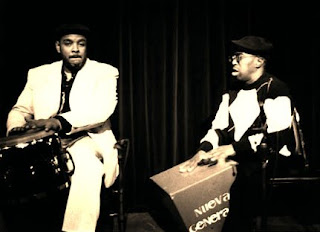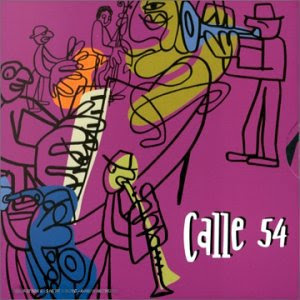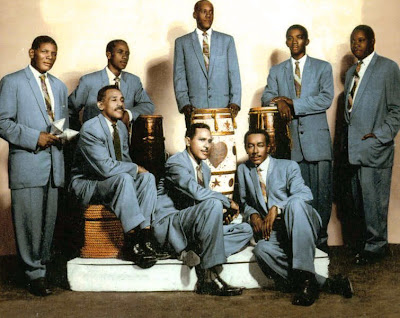TRIBUTE TO PUNTILLA, part 1 in collaboration with the BRECHT FORUM:
DATE & TIME: Sunday, December 7th 6 - 9 pm
PLACE: The Brecht Forum
451 West Street (between Bank & Bethune Streets) NYC
TRIBUTE TO PUNTILLA, part 2, in collaboration with the SCHOMBURG CENTER:
DATE & TIME: Saturday, December 13th 1:30 - 3:00 pm
PLACE: Schomburg Center for Research in Black Culture
515 Malcolm X Blvd, between 135th St. and 136 St. Harlem, NYC
November 16, 2008
For Immediate Release:
Moment In Time Festival:
Tribute to ‘Puntilla’
Honoring Orlando ‘Puntilla’ Rios
Father of the Bata Drum in America
African Music, Dance & Theatre for Global Understanding and Peace
Free Admission
Contact: Basha Alade (732) 290-0927, ZEYBRAH@aol.com
or Lisa Vives at globalnews@earthlink.net
This year’s MOMENT IN TIME FESTIVAL will pay tribute to the Afro-Cuban virtuoso Orlando Rios, known familiarly as “Puntilla”, who died in August of this year. His nickname, which refers to the hammering of a finishing nail, describes both his amazing ability to ‘hammer’ out precise melodies on the drums and his small physical stature.
He has influenced generations of Cuban folkloric musicians, both on and off the island. Already a well-known performer when he left Cuba in the 1980 Mariel boatlift, soon after his arrival in New York he revolutionized the Afro-Cuban folkloric community, bringing rhythms, songs, and drumming techniques.
He was well-versed in many folkloric and sacred drumming styles, including yuka, abakuá and rumba, but perhaps his greatest impact in New York was his knowledge of the sacred bata drum, and his willingness to share that knowledge.
Students of all backgrounds rushed to his workshops, hungry for these cultural riches; prior to Puntilla’s arrival, the Cuban musicians with expertise in these areas had been reluctant to share their knowledge.
Puntilla was respected as a ceremonial performer and singer, but he was equally well-known for his collaborations with jazz musicians like Michele Rosewoman. He soon formed his own group, Nueva Generación, and performed throughout the U.S, in Europe and Japan.
ZEYBRAH – a non-profit cultural organization - has brought together members of several dynamic groups that have played with Puntilla and have been influenced by him.
The Brecht Forum will host the first event on Sunday, December 7th from 6-9 p.m.Veteran percussionist Gene Golden (whom Giovany Hidalgo credits as one of his mentors) will lead a group of drummers, singers and dancers drawn from three ensembles, Puntilla’s Nueva Generación, Gene’s Grupo Quinto Mayor and Latin Grammy nominees Raices Habaneras; some of the performers include dancers Xiomara Rodriguez, Rita Macias and Pedro Domech, singer Abraham “Abie” Rodriguez and drummer Michel Aldama. The program will culminate in a rumba abierta – a jam session dedicated to Puntilla’s memory.
The following week will be the second part of the tribute at the Schomburg Center for Research of Black Culture and History, on Saturday, December 13th from 1:30 – 3:00 p.m. as part of their Junior Scholar’s Program open to the public. Following an introduction/ libation by several community elders, Brandon Rosser, a student and performer with Puntilla will offer a personal reflection. Two of Puntilla’s longtime female collaborators – and pioneers in their own right – will round out the program with excerpts of their work.
Amma Mcken is the director and co-founder with Olukose Wiles (past honoree of Moment in Time) of the group Omi Yesa, founded in 1972, making it the oldest African-American cultural group. In June 2007 she released an album called Alaako Oso, (“the owner of the song is elegant”) for which Puntilla was the musical director. Omi Yesi will present a musical selection tribute based on the Afro-Cuban Yoruba tradition, featuring outstanding percussionists and dancers, including Neil Clarke and Larry Washington.
Michele Rosewoman, a pioneer in blending Afro-Cuban traditions and contemporary jazz, will perform with members of her group New Yor-Uba. In 1983 Michele received a National Endowment for the Arts grant for the formation of this group, which featured Puntilla; the ensemble premiered at Joseph Papp's Public Theater in NYC. New Yor-Uba will perform sacred cantos (chants) and bata (two-headed Cuban drum) in a contemporary jazz setting in tribute to Puntilla, with renowned percussionists Pedro Martinez, Roman Diaz and Mauricio Herrera and bassist Armando Gola.
The Moment in Time Festival is a cultural celebration produced by ZEYBRAH (Zest for Youth Brings Rhythm Arts and Humanities), in collaboration with the Junior Scholar’s Program of the Schomburg Center for Research in Black Culture, and The Brecht Forum. ZEYBRAH, a nonprofit organization, has been organizing cultural festivals in NYC since 1984. Previous honorees include Afro-beat pioneer Fela Anakulapo Kuti and his mother, woman’s rights activist Fumilayo Anakulapo Kuti; the Obalesu of Nigeria; famed drummers/stilt walkers Baba Kwame Ishangi and Baba Olukose Wiles; Mongo Santamaria, Afro-Cuban /jazz pioneer, Papa Ladji Camara, Father of the Djembe Drum in America; President/Poet Leopold Senghor, Balogun Love, and Maguette Fall.
TRIBUTE TO PUNTILLA, part 1 in collaboration with the BRECHT FORUM
DATE & TIME: Sunday, December 7th 6 - 9 pm
PLACE: The Brecht Forum
451 West Street (between Bank & Bethune Streets) NYC
TRIBUTE TO PUNTILLA, part 2, in collaboration with the SCHOMBURG CENTER
DATE & TIME: Saturday, December 13th 1:30 - 3:00 pm
PLACE: Schomburg Center for Research in Black Culture
515 Malcolm X Blvd, between 135th St. and 136 St. Harlem, NYC
Zest for Education of Youth Brings Rhythm Arts and Humanities









































